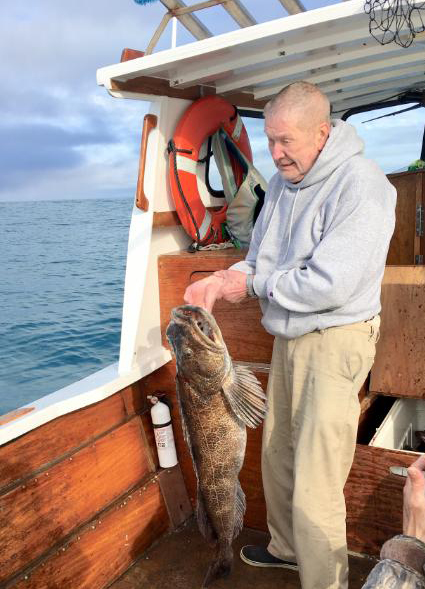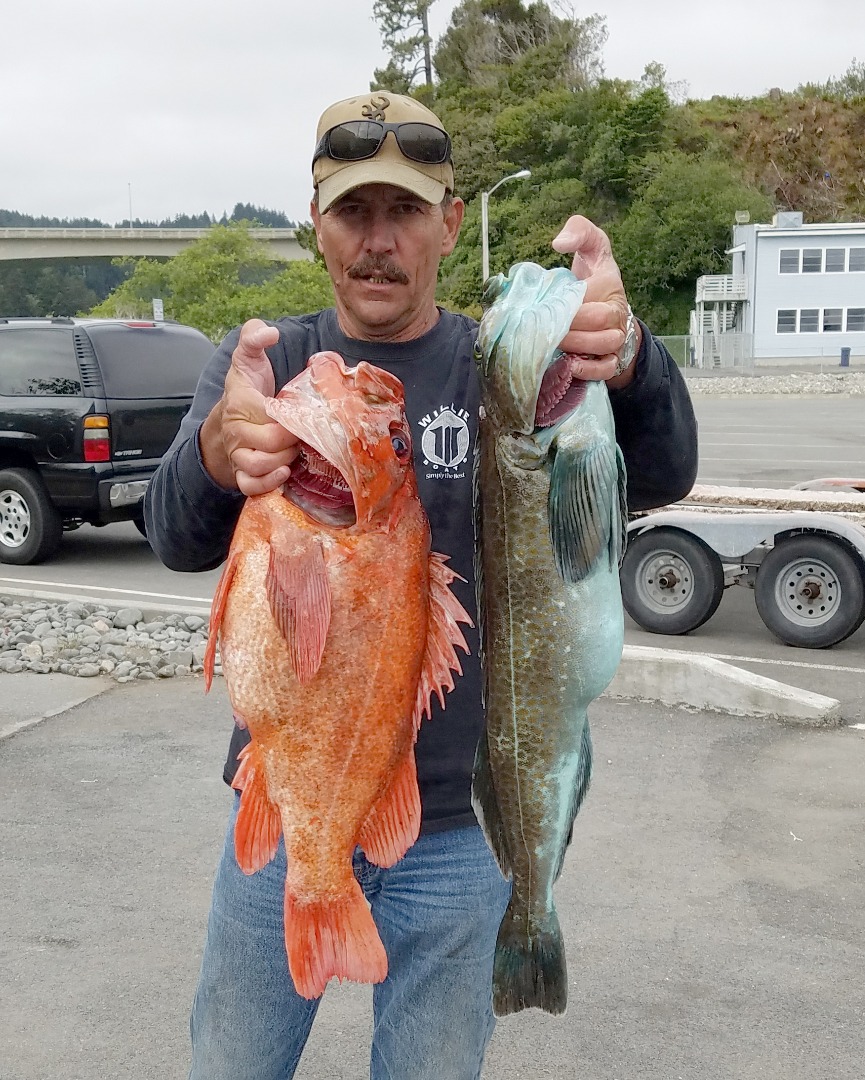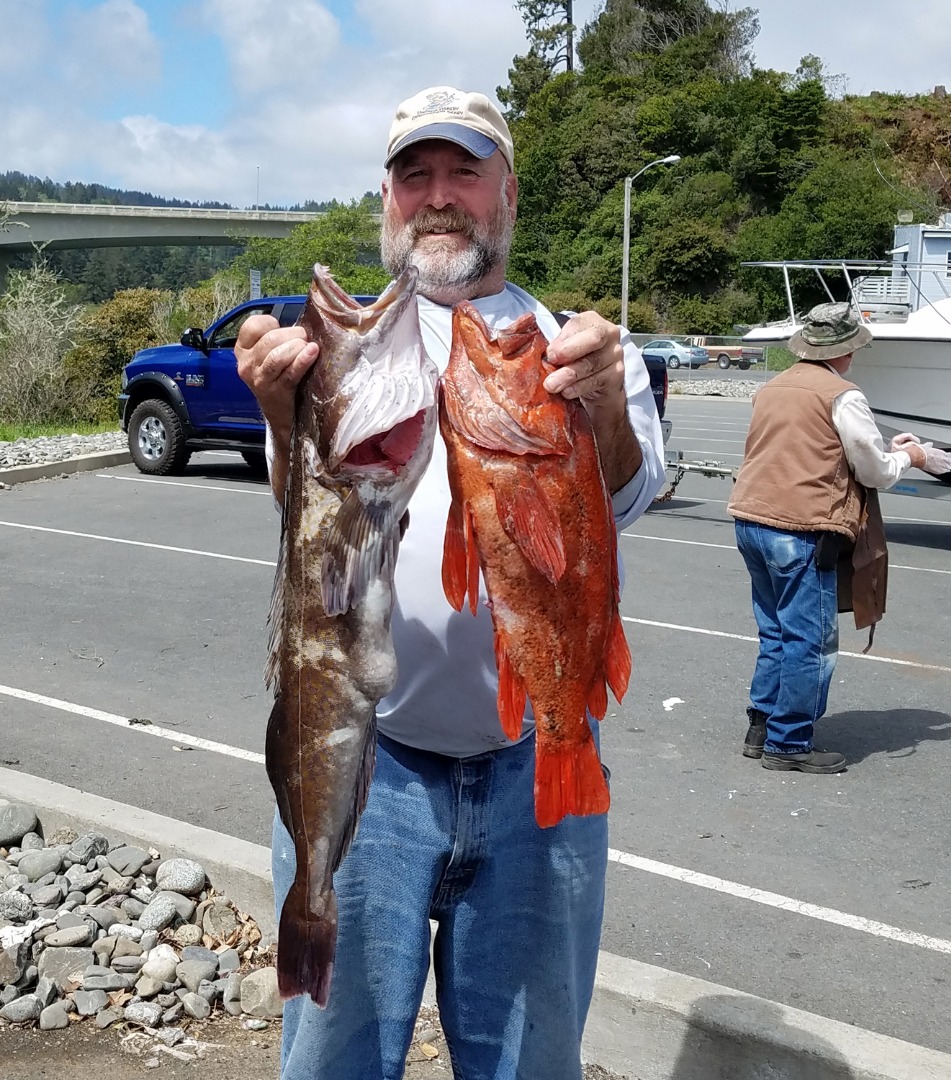Fish Report for 5-26-2018
KMZ Chinook, Bottomfish and Surfperch Highlight Ocean Action

by Larry Ellis
5-26-2018
Website
As was stated in last week's column, finding a Chinook in the ocean was a matter of merely finding the fish, and although last week's action was not red hot by any means, the sportfishing fleet did eventually find the fish.
At least one segment of the king population was discovered between 8 and 11 miles from shore just north of the 42-degree line, straddling the Oregon/California border.
Most of the kings were short but highly girthy specimens, almost resembling the body shape of a springer, with most of them weighing between 6 and 12 pounds - obviously 3-year-old kings. The vast majority of salmon were caught anywhere from 100 to 200 feet on-the-wire.
On-the-wire refers to the depth that a salmon is caught below the surface of the water. It is the length of wire that is dragging a downrigger ball, so obviously most boats were utilizing their downriggers to get their baits down to the fish.
So if you were wondering where all those predicted 330,000 3-year-old Klamath River Chinook have been hanging their hat in the ocean, wonder no more.
"Klamath River salmon spend most of their time feeding further out from shore and deeper than other salmon," said Richard Heap, the Oregon representative on the KMZ subpanel. "So it doesn't surprise me that they would be 10 miles out and up to 200 feet deep."
In addition, most anglers who were having the best luck were getting to their spot at zero dark thirty, or one hour before the sun rises.
Furthermore, the presence of krill has been spotted earlier in the week, giving Chinook flesh that ultra-red appearance.
Moreover, anglers have been noting that there have been a more-than-usual amount of smaller-size kings that had to be released. The minimum size for Chinook in Oregon is 24 inches.
This tells me that there might be a lot of Klamath River jacks escaping to the that particular river after September 1.
A lot of salmon fishermen were telling me that smaller vessels were not even considering venturing out 10 miles.
But don't let the size of your vessel get you down. The larger Sacramento River and Rogue River Chinook will soon be putting a bend in your rod closer to shore.
Bottomfishing Excellent!
Anglers who have been leery about venturing 10 miles from shore have been having plenty of action on bottom-grabbers which have been closer to the Port of Brookings Harbor's jaws.
Fishing for large rockfish has been second to none, with a mixed variety of various types of the Sebastes genus hitting anything and everything from soft plastics to leadfish. Some very large blacks have been meeting the sharpened ends of fillet knives, especially those who are deploying kayaks and fishing closer to the kelp.
In addition to black rockfish, blue rockfish, canary rockfish and vermilion rockfish have been scattered through anglers' ice chests.
Additionally, limits of lingcod averaging between 8 and 12 pounds have been coming to the fillet tables with regularity, with some lings in the 20-pound category being filleted as well.
If you are serious about catching larger rockfish and lingcod, take off those shrimp flies and go one-on-one with your bottomfish. With a limit now of 5 rockfish, two drops with a gangion of shrimp flies will quickly end your day.
So for the biggest bang for your buck, put on a jig head weighing anywhere from 1/2 to 2 ounces and put either a swimbait or a jerkbait on the back end. You may get less takedowns but the ones you get will be well worth your casts.
For decades, fishing has been defined as 'a jerk on one end of a line waiting for a jerk at the other end'.
But if you use a 2-ounce jighead with a 5-1/2-inch jerkbait trailing behind it, the only jerks will come from fish eating your jerkbaits. Jerkbaits can be bought in ever color and flavor, but the jerkbaits made by D.O.A. Lures are pieces of plastic waiting for a bite to happen.
As far as colors go, you can never go wrong with white, but Nite Glow and Melon Back are my favorite go-to colors.
The Lower Rogue
Fishing for springers on the lower Rogue River had taken a brief hiatus. But one Gold Beach sporting goods store owner is holding out hope that a new run could be hitting the area any time now.
"We're still seeing 2 or 3 fresh fish a day, and there are guides who are fishing upriver who are getting some springers," said Jim Carey from the Rogue Outdoor Store on Thursday. "And those are some fresh fish that have come in. So I don't feel that the whole thing's over with yet. I'm of the opinion that we still have fish off the mouth, and if we were to have rain, they definitely would move in."
But let's take the worse-case scenario and assume that there will not be any measurable rain for the rest of the season. That situation could create another early Rogue bay trolling fishery, with fish stacking up in the bay like cordwood, giving trollers the definite advantage.
And let us not forget, last year's Rogue bay Chinook fishery kicked in around the first week of June, which is just around the corner.
Surfperch Fishing Still Going Strong in Gold Beach and Brookings
For anglers who prefer fishing in the surf, redtail and striped surfperch have been eating raw shrimp and lugworms about as fast as you can cast.
"Fishing for redfin surfperch seems to be still going strong," says Carey. "Some of them are in the 3-pound category with even some over 4 pounds."
Starting at the Oregon/California border, great places to fish for surfperch are at Crissey Field, McVay Park, Sporthaven Beach, Chetco Point Park and Mill Beach.
As you get toward Gold Beach, Kissing Rock at the mouth of Hunter Creek, and downhill from the Nesika Beach Wayside are also great spots.
When fishing from the surf, always be on the lookout for sneaker waves. Sneaker waves can approach you from the front, from surfline itself. But folks also need to remember that they can also come from behind you and catch you off guard, especially on steep, sloping beaches.
Tight lines!
Larry Ellis, author, writer, columnist and photographer has had a 50-year passion for fishing in California and Oregon's saltwater and freshwater venues. He is a well-known writer for Oregon, Washington and California Fishing and Hunting News, Northwest Sportsman, California Sportsman and Pacific Coast Sportfishing. He currently writes monthly for Salmon Trout Steelheader Magazine, and is the author of two books, "Plug Fishing for Salmon" and "Buoy 10, the World's Largest Salmon Run." Both books can be bought from Amato Publications (amatobooks.com), Amazon and eBay. Ellis particularly loves living in his hometown of Brookings, Oregon - The heart of salmon country and gateway to fishing paradise.

Website Hosting and Design provided by TECK.net

